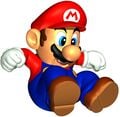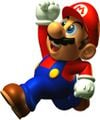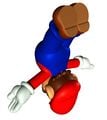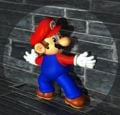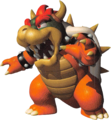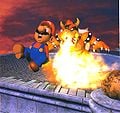Super Mario 64
Super Mario 64 is a 3D platform adventure game for the Nintendo 64. It was first released in Japan on June 23, 1996; in the U.S. on September 29, 1996; and in Europe on March 1, 1997. This game was one of two launch titles for the Nintendo 64, along with PilotWings 64, which helped drive initial sales of the console. To date, it has sold over 11 million copies, and is the second most popular game on the Virtual Console.
Super Mario 64 was originally in development for the Super Famicom, or SNES outside of Japan, but was moved to the Nintendo 64 after limitations proved very hassling. Though it was not the first 3D platforming game, it revolutionized the genre, with many games soon following its formula using it as a sort of benchmark. It is widely acclaimed as one of the greatest games of all time.
A version of the game was released in Japan on July 18, 1997, that included Rumble Pak support.
Super Mario 64 had a remake for the Nintendo DS called Super Mario 64 DS. The remake had various differences from the original game. There was also a sequel planned called Super Mario 64 2, though it was cancelled.
Contrary to popular belief, this game was technically not the debut of Charles Martinet as Mario's voice (It actually debuted in Mario's FUNdamentals), it was the first time most people heard it, and is thus regarded as its effective debut.
Storyline
Princess Peach Toadstool sent a letter to Mario to come and have some cake with her in the castle. When he arrives, he finds one of the Lakitu Bros. who follows him around dangling a camera. Together, they go inside and hear a familiar voice telling them to get out of the castle. Toad informs them that Bowser has kidnapped the princess again and is holding everyone hostage inside the castle walls. He has also stolen the Power Stars and given them to his minions who are hiding in paintings. Mario hops in the magical paintings and retrieves the Power Stars in order to defeat Bowser and save the Princess.
After a long journey, Mario counts his stars and discovers he has enough of them to go into Bowsers final maze, and goes through another one of the Koopa King's obstacle courses. Once getting through, Mario finds Bowser waiting for him. The two engage in battle. Bowser ends up defeated, and is surprised when Mario tells him there were some power stars he missed. Bowser gives up, and hands Mario the final Giant Power Star before he explodes. When Mario grabs the last power star, wings appear on his cap, allowing him to fly. He circles the star-shaped arena, and flies away. Eventually, he lands in front of the castle.
As his wings fade away, Mario uses the power of the Giant Power Star, to make Princess Peach appear in front of the castle. The star goes into the painting, the painting flashes, and Peach slowly descends to the ground. Mario rushes up to her as she wakes up. Thanking him, Peach kisses Mario and says she will make a cake for him. Peach and two nearby Toads walk into the castle. Mario starts to do so himself, but then pauses and turns around to look at the sky, and watch the birds flying. Peach calls his name and Mario runs in after her and the Toads. After the credits scroll, the cake, with Peach and Mario figures, is shown at the very end. Template:Endspoiler
Courses
Levels are laid out inside paintings in the castle, or sometimes the walls themselves. They can also be found in holes, gaps, oil pits, and inside a clock. Each world has 7 Power Stars. Within each, one of which is gained by finding 100 coins in the level. The other six Stars are found by performing "missions", fighting bosses, winning races, and etc. Every course has boundaries to limit the player from going too far, either as a strict wall or an invisible boundary. If Mario hits either, he falls down (quite often to his death). Otherwise, Mario is free to roam the large expansive levels at his leisure.
Levels often feature pink Bob-ombs called Bob-omb Buddies. They open cannons littered around the levels for Mario to fly with. When the cannon is open, Mario simply falls into the pit where it is, and it raises. The player targets the cannon with a cross hair shot, and fires. This helps Mario reach high or far away areas. It is often a good idea to use the Wing Cap (see below) with cannons.
- Bob-omb Battlefield
- Whomp's Fortress
- Jolly Roger Bay
- Cool, Cool Mountain
- Big Boo's Haunt
- Hazy Maze Cave
- Lethal Lava Land
- Shifting Sand Land
- Dire, Dire Docks
- Snowman's Land
- Wet-Dry World
- Tall Tall Mountain
- Tiny-Huge Island
- Tick Tock Clock
- Rainbow Ride
Secret Courses
In addition to the main courses of the game and the Bowser Courses, there are also a few hidden courses that house several of the Castle's Secret Stars, as well as the three ! Switches.
- The Princess's Secret Slide
- The Secret Aquarium
- Tower of the Wing Cap
- Vanish Cap Under the Moat
- Cavern of the Metal Cap
- Winged Mario Over the Rainbow
Abilities
In addition to Mario's signature Jumping, a whole new host of abilities is given to the player as the game progresses. Mario can punch, kick, kick jump, hip drop (Yoshi and Wario could do this previously), triple jump, long jump, back slip, somersault, and perform the wall kick (bouncing from wall to wall with timed jumps to reach higher areas). Also, the usual Super Mushroom and Fire Flower are absent in this game. Instead Mario gains the power to wear new hats, in the form of colored Caps.
The Caps are found inside special '!' blocks littered around the every level. Initially empty, they can be filled by finding '!' switches (similar to the Switch Palaces of Super Mario World). There are three colors to the caps, and each cap lets Mario perform different abilities. Some caps may be worn at the same time.
- The Wing Cap (red) allows Mario to transform into Wing Mario and fly around if he triple jumps. This is useful for reaching high or far areas, and finding secrets in the sky. This cap is particularly useful if you find a cannon to jump out of.
- The Vanish Cap (blue) makes Mario transform into Vanish Mario which makes him invulnerable to attacks. He can also walk through some walls to reach new areas or find items such as Stars.
- The Metal Cap (green) Mario to transform into Metal Mario which makes him metallic and heavy. This lets Mario defeat enemies by walking into them, avoid water currents, and walk under water.
Bosses
There are various mini bosses in some stages, but the primary boss is Bowser. He appears three times in three different levels. This is a list of the bosses in the game.
- Big Bob-omb – A giant Bob-omb in Bob-omb Battlefield. He appears as the first star.
- Chain Chomp in Bomb-omb Battlefield you have to release it from its chain while avoding it's attacks.
- Whomp King – A giant Whomp on top of Whomp's Fortress. He appears as the first star, and after he is defeated, there is a tower on top of the fortress.
- Bowser in the Dark World – Bowser appears at the end of this level. You need to swing him by the tail clockwise or counterclockwise and hurl him at bombs on the outside of his circular arena.
- Big Bully – A giant Bully which appears twice in Lethal Lava Land. It tries on both occasions to knock Mario into the lava.
- Eyerok – Two stone hands with eyes on their palms. They appear when you blast open the top of the Pyramid in Shifting Sand Land and ride the elevator inside.
- Big Boo – A giant Boo which appears three times in Big Boo's Haunt. He initially appears once all the Boos in the mansion have been removed, again in the underground Merry-Go-Round, and lastly on the top balcony of the mansion( possibly what inspired Boolossus).
- Big Mr. I – A giant Mr. I which only appears in the attic of Big Boo's Haunt.
- Bowser in the Fire Sea – Bowser appears at the end of the level. Game play is the same as the first Bowser, except now his jumps make the arena tilt, causing Mario to need to run up the arena to avoid falling off. Bowser also gains a new move where he vanishes and reappears a short distance away.
- Chill Bully – A large Bully made of ice. He tries to ram Mario onto a lethally frozen pond in Snowman's Land.
- Wiggler – A giant Wiggler, which becomes angry when his home in Tiny-Huge Island gets flooded.
- Bowser in the Sky – Bowser appears at the end of this level. He must be thrown into the bombs three times. Each time he falls off the arena, his jump back makes a piece of the arena fall off. After being hit twice, he stomps the ground and the entire arena begins collapsing until it becomes the shape of a star.
Voice Cast
Official Artwork
It should be noted that because of the artwork's age and distribution, the contrasts of the original Super Mario 64 artwork vary widely.
Mario
- Mario64victory.gif
Mario's classic pose - Sm64 mariofly.gif
Mario with the Wing Cap - Normal mariobobomblarge.jpeg
Mario carrying a Bob-omb - Mariobowser.jpeg
Mario swinging Bowser - Marioheadslide.jpg
Mario sliding on his stomach - Mario64sleeping.gif
Mario sleeping - Mario64mad.gif
Mario upset with something - Mario64upset2.jpg
Another upset Mario - Mario64net.gif
Mario climbing something overhead - Mario64point.gif
Mario pointing at something - Mariopunch.gif
Mario using his main attack - Mario64punch2.gif
Another angle of Mario punching - Mario64push.jpg
Mario pushing his way though - Mario64run2.gif
Mario running faster - Mario64walk.jpg
Mario walking - Mario64sidekick.gif
Mario using his sidekick - Mario64slide.gif
Mario sliding on his stomach again - Mario64swim2.jpg
Mario swimming - Marioswim64.jpg
Mario swimming - Marioswim642.jpg
Mario swimming - Marioswim643.jpg
Mario swimming - Mario64kick.jpg
Mario kicking - Mario64presents.jpg
Mario presenting - Mario64smile.jpg
Mario's ending pose - Sm64mariojump2.jpg
Mario doing a double jump - Mariolean64.gif
Mario leaning on something - Mariocreep.jpg
Mario creeping against the wall - Mario64crawl.gif
Mario crawling - Metalmario64.gif
Metal Mario
Other Characters
- Princess Peach Super Mario 64.png
- Bowsersm64.gif
- Bowserlookdown2.gif
- Bowserfirebreath.png
Mario and Bowser fighting - Penguin.jpg
Mama Penguin and her baby
Items
- Greenmushroom64.jpg
- Wingcapblock.jpg
Wing Cap Block - Vanishcapblock.jpg
Vanish Cap Block - Metalcapblock.jpg
Metal Cap Block
Trivia
- There are many glitches in this game, that, when utilized, allow a player to complete the game with 16 stars in as little as 16 minutes, instead of the previously required 70 stars. Up until recently, those glitches were the only known, however now there are glitches to beat the game with 1 or even 0 stars in 5 minutes. [1]
- Mario's method of defeating Bowser in this game is identical to the one he used in The Great Mission to Save Princess Peach.
- The title screen of the game features the ability to grab Mario's face with the hand cursor and distort it in various bizarre ways. This Mario's name is called mario mini. In Mario Kart 64 DS, you can also play with Yoshi's face, or draw your own picture to distort.
- In the beta level, Mario's third jump in his triple jump would cause him to do his helicopter spin which was eventually only available to when he jumped on certain enemies.
- When Super Mario 64 was being localized for the English speaking countries, many small changes were made. For example, Princess Toadstool never read her letter aloud in Japanese Super Mario 64. In 1997, Super Mario 64 was re-released in Japan as "Shindou edition." It featured all the changes from the English game, plus rumble pack support.
- As a little easter egg, sometimes when Mario jumps out of water a fish flies out with him. As shown by the picture above, this is much easier to do when jumping out of shallow water.
- Super Mario 64 is one of the few Mario mainstream games, along with Super Mario Sunshine, to not have a single reference to Luigi.
| Nintendo 64 games | ||
|---|---|---|
| Super Mario franchise | Super Mario 64 (1996) • Mario Kart 64 (1996) • Mario no Photopi (1998) • Mario Party (1998) • Mario Golf (1999) • Mario Artist: Paint Studio* (1999) • Mario Party 2 (1999) • Mario Artist: Talent Studio* (2000) • Mario Artist: Communication Kit* (2000) • Mario Tennis (2000) • Paper Mario (2000) • Mario Artist: Polygon Studio* (2000) • Mario Party 3 (2000) • Dr. Mario 64 (2001) | |
| Donkey Kong franchise | Diddy Kong Racing (1997) • Donkey Kong 64 (1999) | |
| Yoshi franchise | Yoshi's Story (1997) | |
| Crossovers | Super Smash Bros. (1999) | |
Template:Fourth Wall Template:VirtualConsole




